Material Health of NiCrBSi Alloy Parts Produced via the Laser Powder Bed Fusion Process
Abstract
:1. Introduction
2. Materials and Methods
2.1. Material
2.2. LPB-F Production
- Standard L-PBF productions (Figure 2) were carried out using a Renishaw AM400 with a standard baseplate (250 × 250 mm) heated to 170 °C. A laser power of 150, 175, 200, and 225 W is used. Various exposure times between 20 and 140 µs and point distances between 20 and 140 µm are tested. According to several papers in the field of nickel-based superalloys produced with a Renishaw AM400 device [53,54,55,56,57,58,59], parameter sets leading to a linear energy lower than 0.15 J·mm−1 and greater than 0.35 J·mm−1 and a VED greater than 130 J·mm−3 are not tested. Finally, the hatch distance was kept at 70 µm, except for the four samples obtained with an Hd between 50 and 110 µm. In total, 75 samples (cubes of 13 × 14 × 15 mm3) out of 76 were built (Figure 2a,c).
- High-temperature L-PBF production and laser remelting exploration were conducted with a modified SLM Solution 250 device (continuous laser) on a small round baseplate (100 mm diameter). Two preheating temperatures were tested: 300 and 500 °C. For 300 °C (Figure 2), a laser power of 100 and 150 W was used, and the laser scanning speed varied between 450 and 800 mm·s−1. Hatch spacing was kept at 70 µm. In total, 8 out of 16 samples (cubes of 10 × 10 × 10 mm3) were built (Figure 2b,d).
- For 500 °C (Figure 2), according to results obtained at 300 °C, a laser power of 100 W was mainly used with a laser speed between 100 and 1200 mm·s−1. A laser power of 150 W and laser speed of 600 mm·s−1 were also tested. Hatch spacing varied from 30 to 110 µm for four samples, and it was kept at 70 µm for the rest of the production. In total, 19 out of 20 samples (cubes of 10 × 10 × 10 mm3) were built (Figure 2b,d)).
- Finally, four samples were produced with laser remelting (same parameters as the first laser path) on a baseplate preheated at 500 °C. Two samples were obtained with a laser power of 100 W, a laser speed of 200 mm·s−1, and a hatch spacing of 30 and 110 µm. Two other samples were constructed with a laser power of 150 W, a laser speed of 600 mm·s−1, and a hatch spacing of 30 and 110 µm. In total, 3 out of 4 samples (cubes of 10 × 10 × 10 mm3) were built. Those parameter sets are chosen for their capacity to produce a few cracks (Figure 2b,d)).
2.3. Sample Preparation
2.4. Defects Detection and Analysis
2.5. Defects Quantification
3. Results
3.1. Processability
3.2. Material Health
3.2.1. Qualitative Defect Analysis
3.2.2. Quantitative Defect Analysis
4. Discussion
4.1. Processability
4.2. Lack of Fusion
4.3. Cracks
4.4. Process Optimization
5. Conclusions
- Given that circular objects with a coarse microstructure are frequently observed with a lack of fusion, powder bed screening due to spatters emerging from the melting pool is the reason for the large lack of fusion;
- Preheating the baseplate up to 500 °C reduces the surface fraction of areas with a lack of fusion to less than 1%;
- Given the brittle fracture surface, cracking is most likely to occur in a solid state;
- Preheating the baseplate up to 500 °C generates widely spaced, shorter, and wider cracks due to the sample’s softening and/or thermal gradient reduction.
- The wide cracks concentrated at the sample’s corners might engender catastrophic flacking after sample preparation or under load;
- Process parameters set at a laser power of 150 W, a laser scanning speed of 732 mm·s−1, a hatch spacing of 70 µm, and a preheating temperature of 170 °C show a good compromise for obtaining a surface density of 98%, with narrow cracks that are 11 µm wide, while limiting the crack’s length per unit of area to 4 ± 0.4 mm.mm−2.
Author Contributions
Funding
Data Availability Statement
Acknowledgments
Conflicts of Interest
References
- Tong, X.; Li, F.; Liu, M.; Dai, M.; Zhou, H. Thermal Fatigue Resistance of Non-Smooth Cast Iron Treated by Laser Cladding with Different Self-Fluxing Alloys. Opt. Laser Technol. 2010, 42, 1154–1161. [Google Scholar] [CrossRef]
- Feldshtein, E.; Kardapolava, M.; Dyachenko, O. On the Effectiveness of Multi-Component Laser Modifying of Fe-Based Self-Fluxing Coating with Hard Particulates. Surf. Coat. Technol. 2016, 307, 254–261. [Google Scholar] [CrossRef]
- Simunovic, K.; Saric, T.; Simunovic, G. Different Approaches to the Investigation and Testing of the Ni-Based Self-Fluxing Alloy Coatings—A Review. Part 1: General Facts, Wear and Corrosion Investigations. Tribol. Trans. 2014, 57, 955–979. [Google Scholar] [CrossRef]
- Serres, N.; Hlawka, F.; Costil, S.; Langlade, C.; Machi, F. Microstructures of Metallic NiCrBSi Coatings Manufactured via Hybrid Plasma Spray and In Situ Laser Remelting Process. J. Therm. Spray Technol. 2011, 20, 336–343. [Google Scholar] [CrossRef]
- Wang, D.; Liang, E.; Chao, M.; Yuan, B. Investigation on the Microstructure and Cracking Susceptibility of Laser-Clad V2O5/NiCrBSiC Alloy Coatings. Surf. Coat. Technol. 2008, 202, 1371–1378. [Google Scholar] [CrossRef]
- Sidhu, T.S.; Prakash, S.; Agrawal, R.D. Hot Corrosion Behaviour of HVOF-Sprayed NiCrBSi Coatings on Ni- and Fe-Based Superalloys in Na2SO4–60% V2O5 Environment at 900 °C. Acta Mater. 2006, 54, 773–784. [Google Scholar] [CrossRef]
- Chen, H.; Xu, C.; Qu, J.; Hutchings, I.M.; Shipway, P.H.; Liu, J. Sliding Wear Behaviour of Laser Clad Coatings Based upon a Nickel-Based Self-Fluxing Alloy Co-Deposited with Conventional and Nanostructured Tungsten Carbide–Cobalt Hardmetals. Wear 2005, 259, 801–806. [Google Scholar] [CrossRef]
- McCarron, R.; Stewart, D.; Shipway, P.; Dini, D. Sliding Wear Analysis of Cobalt Based Alloys in Nuclear Reactor Conditions. Wear 2017, 376–377, 1489–1501. [Google Scholar] [CrossRef]
- McCarron, R. An Investigation of the Wear Resistance of Bearing Materials for Nuclear Applications. Ph.D. Thesis, Imperial College London, London, UK, 2018. [Google Scholar]
- Sudha, C.; Shankar, P.; Rao, R.V.S.; Thirumurugesan, R.; Vijayalakshmi, M.; Raj, B. Microchemical and Microstructural Studies in a PTA Weld Overlay of Ni–Cr–Si–B Alloy on AISI 304L Stainless Steel. Surf. Coat. Technol. 2008, 202, 2103–2112. [Google Scholar] [CrossRef]
- Kazamer, N.; Muntean, R.; Vălean, P.C.; Pascal, D.T.; Mărginean, G.; Șerban, V.-A. Comparison of Ni-Based Self-Fluxing Remelted Coatings for Wear and Corrosion Applications. Materials 2021, 14, 3293. [Google Scholar] [CrossRef]
- Lebaili, S.; Durand-Charre, M.; Hamar-Thibault, S. The Metallurgical Structure of As-Solidified Ni-Cr-B-Si-C Hardfacing Alloys. J. Mater. Sci. 1988, 23, 3603–3611. [Google Scholar] [CrossRef]
- Liyanage, T.; Fisher, G.; Gerlich, A.P. Influence of Alloy Chemistry on Microstructure and Properties in NiCrBSi Overlay Coatings Deposited by Plasma Transferred Arc Welding (PTAW). Surf. Coat. Technol. 2010, 205, 759–765. [Google Scholar] [CrossRef]
- Hemmati, I.; Rao, J.C.; Ocelík, V.; De Hosson, J.T.M. Electron Microscopy Characterization of Ni-Cr-B-Si-C Laser Deposited Coatings. Microsc. Microanal. Off. J. Microsc. Soc. Am. Microbeam Anal. Soc. Microsc. Soc. Can. 2013, 19, 120–131. [Google Scholar] [CrossRef] [PubMed]
- Vafadar, A.; Guzzomi, F.; Rassau, A.; Hayward, K. Advances in Metal Additive Manufacturing: A Review of Common Processes, Industrial Applications, and Current Challenges. Appl. Sci. 2021, 11, 1213. [Google Scholar] [CrossRef]
- Frazier, W.E. Metal Additive Manufacturing: A Review. J. Mater. Eng. Perform. 2014, 23, 1917–1928. [Google Scholar] [CrossRef]
- Zheng, H.; Li, H.; Lang, L.; Gong, S.; Ge, Y. Effects of Scan Speed on Vapor Plume Behavior and Spatter Generation in Laser Powder Bed Fusion Additive Manufacturing. J. Manuf. Process. 2018, 36, 60–67. [Google Scholar] [CrossRef]
- Sanchez, S.; Smith, P.; Xu, Z.; Gaspard, G.; Hyde, C.J.; Wits, W.W.; Ashcroft, I.A.; Chen, H.; Clare, A.T. Powder Bed Fusion of Nickel-Based Superalloys: A Review. Int. J. Mach. Tools Manuf. 2021, 165, 103729. [Google Scholar] [CrossRef]
- Volpato, G.M.; Tetzlaff, U.; Fredel, M.C. A Comprehensive Literature Review on Laser Powder Bed Fusion of Inconel Superalloys. Addit. Manuf. 2022, 55, 102871. [Google Scholar] [CrossRef]
- Adegoke, O.; Andersson, J.; Brodin, H.; Pederson, R. Review of Laser Powder Bed Fusion of Gamma-Prime-Strengthened Nickel-Based Superalloys. Metals 2020, 10, 996. [Google Scholar] [CrossRef]
- Adegoke, O.; Andersson, J.; Brodin, H.; Pederson, R. Influence of Laser Powder Bed Fusion Process Parameters on Voids, Cracks, and Microhardness of Nickel-Based Superalloy Alloy 247LC. Materials 2020, 13, 3770. [Google Scholar] [CrossRef]
- Adegoke, O.; Polisetti, S.R.; Xu, J.; Andersson, J.; Brodin, H.; Pederson, R.; Harlin, P. Influence of Laser Powder Bed Fusion Process Parameters on the Microstructure of Solution Heat-Treated Nickel-Based Superalloy Alloy 247LC. Mater. Charact. 2022, 183, 111612. [Google Scholar] [CrossRef]
- Lee, Y.S.; Kirka, M.M.; Kim, S.; Sridharan, N.; Okello, A.; Dehoff, R.R.; Babu, S.S. Asymmetric Cracking in Mar-M247 Alloy Builds During Electron Beam Powder Bed Fusion Additive Manufacturing. Metall. Mater. Trans. Uncorrected Proof 2018, 49, 5065–5079. [Google Scholar] [CrossRef]
- Perevoshchikova, N.; Rigaud, J.; Sha, Y.; Heilmaier, M.; Finnin, B.; Labelle, E.; Wu, X. Optimisation of Selective Laser Melting Parameters for the Ni-Based Superalloy IN-738 LC Using Doehlert’s Design. Rapid Prototyp. J. 2017, 23, 881–892. [Google Scholar] [CrossRef]
- Wang, X.; Carter, L.N.; Pang, B.; Attallah, M.M.; Loretto, M.H. Microstructure and Yield Strength of SLM-Fabricated CM247LC Ni-Superalloy. Acta Mater. 2017, 128, 87–95. [Google Scholar] [CrossRef]
- Muñoz-Moreno, R.; Divya, V.D.; Driver, S.L.; Messé, O.M.D.M.; Illston, T.; Baker, S.; Carpenter, M.A.; Stone, H.J. Effect of Heat Treatment on the Microstructure, Texture and Elastic Anisotropy of the Nickel-Based Superalloy CM247LC Processed by Selective Laser Melting. Mater. Sci. Eng. A 2016, 674, 529–539. [Google Scholar] [CrossRef]
- Boswell, J.H.; Clark, D.; Li, W.; Attallah, M.M. Cracking during Thermal Post-Processing of Laser Powder Bed Fabricated CM247LC Ni-Superalloy. Mater. Des. 2019, 174, 107793. [Google Scholar] [CrossRef]
- Carter, L.N.; Wang, X.; Read, N.; Khan, R.; Aristizabal, M.; Essa, K.; Attallah, M.M. Process Optimisation of Selective Laser Melting Using Energy Density Model for Nickel Based Superalloys. Mater. Sci. Technol. 2016, 32, 657–661. [Google Scholar] [CrossRef]
- Carter, L.N. Selective Laser Melting of Nickel Superalloys for High Temperature Applications. Ph.D. Thesis, University of Birmingham, Birmingham, UK, 2013. [Google Scholar]
- Carter, L.; Attallah, M.; Reed, R. Laser Powder Bed Fabrication of Nickel-Base Superalloys: Influence of Parameters; Characterisation, Quantification and Mitigation of Cracking. In Superalloys 2012; John Wiley & Sons, Ltd.: Hoboken, NJ, USA, 2012; pp. 577–586. ISBN 978-0-470-94320-5. [Google Scholar]
- Griffiths, S.; Ghasemi Tabasi, H.; Ivas, T.; Maeder, X.; De Luca, A.; Zweiacker, K.; Wróbel, R.; Jhabvala, J.; Logé, R.E.; Leinenbach, C. Combining Alloy and Process Modification for Micro-Crack Mitigation in an Additively Manufactured Ni-Base Superalloy. Addit. Manuf. 2020, 36, 101443. [Google Scholar] [CrossRef]
- Griffiths, S.; Ghasemi-Tabasi, H.; De Luca, A.; Pado, J.; Joglekar, S.S.; Jhabvala, J.; Logé, R.E.; Leinenbach, C. Influence of Hf on the Heat Treatment Response of Additively Manufactured Ni-Base Superalloy CM247LC. Mater. Charact. 2021, 171, 110815. [Google Scholar] [CrossRef]
- Guo, C.; Li, G.; Zhou, F.; Li, X.; Xu, Z.; Liu, C.; Hu, X.; Lu, H.; Li, Z.; Zhu, Q. Understanding the Significant Effect of Boron Content on the Printability of IN738LC Superalloy Fabricated Using Laser Powder Bed Fusion. Opt. Laser Technol. 2023, 159, 108954. [Google Scholar] [CrossRef]
- Geiger, F.; Kunze, K.; Etter, T. Tailoring the Texture of IN738LC Processed by Selective Laser Melting (SLM) by Specific Scanning Strategies. Mater. Sci. Eng. A 2016, 661, 240–246. [Google Scholar] [CrossRef]
- Qiu, C.; Chen, H.; Liu, Q.; Yue, S.; Wang, H. On the Solidification Behaviour and Cracking Origin of a Nickel-Based Superalloy during Selective Laser Melting. Mater. Charact. 2019, 148, 330–344. [Google Scholar] [CrossRef]
- Cloots, M.; Uggowitzer, P.J.; Wegener, K. Investigations on the Microstructure and Crack Formation of IN738LC Samples Processed by Selective Laser Melting Using Gaussian and Doughnut Profiles. Mater. Des. 2016, 89, 770–784. [Google Scholar] [CrossRef]
- Kim, K.-S.; Yang, S.; Kim, M.-S.; Lee, K.-A. Effect of Post Heat-Treatment on the Microstructure and High-Temperature Oxidation Behavior of Precipitation Hardened IN738LC Superalloy Fabricated by Selective Laser Melting. J. Mater. Sci. Technol. 2021, 76, 95–103. [Google Scholar] [CrossRef]
- Bayoumy, D.; Kan, W.; Wu, X.; Zhu, Y.; Huang, A. The Latest Development of Sc-Strengthened Aluminium Alloys by Laser Powder Bed Fusion. J. Mater. Sci. Technol. 2023. [Google Scholar] [CrossRef]
- Zeng, C.; Ding, H.; Bhandari, U.; Guo, S.M. Design of Crack-Free Laser Additive Manufactured Inconel 939 Alloy Driven by Computational Thermodynamics Method. MRS Commun. 2022, 12, 844–849. [Google Scholar] [CrossRef]
- Shishkovsky, I.; Kakovkina, N.; Sherbakof, V. Mechanical Properties of NiCrBSi Self-Fluxing Alloy after LPBF with Additional Heating. Procedia CIRP 2020, 94, 217–221. [Google Scholar] [CrossRef]
- Wang, W.Q.; Li, Y.Q.; Li, X.; Liu, L.; Chen, F. Microstructures and Properties of Ni-Cr-B-Si Alloy Powders Prepared by Selective Laser Melting. Mater. Rep. 2020, 34, 2077–2082. [Google Scholar]
- Abe, F.; Osakada, K.; Shiomi, M.; Uematsu, K.; Matsumoto, M. The Manufacturing of Hard Tools from Metallic Powders by Selective Laser Melting. J. Mater. Process. Technol. 2001, 111, 210–213. [Google Scholar] [CrossRef]
- Shishkovsky, I.; Kakovkina, N.; Scherbakov, V. Fabrication of Heat-Resisting Nickel Composite Gradient Structures with TiC Nano Additive during Powder Bed Fusion Process. Procedia CIRP 2018, 74, 68–71. [Google Scholar] [CrossRef]
- Shishkovsky, I.; Kakovkina, N.; Sherbakov, V. Layerwise Fabrication of Refractory NiCrSiB Composite with Gradient Grow of Tungsten Carbide Additives by Selective Laser Melting. Opt. Laser Technol. 2019, 120, 105723. [Google Scholar] [CrossRef]
- Ji, W.; Liu, C.; Dai, S.; Deng, R. Microstructure, Properties and Crack Suppression Mechanism of High-Speed Steel Fabricated by Selective Laser Melting at Different Process Parameters. Chin. J. Mech. Eng. 2023, 36, 46. [Google Scholar] [CrossRef]
- Kempen, K.; Vrancken, B.; Buls, S.; Thijs, L.; Van Humbeeck, J.; Kruth, J.-P. Selective Laser Melting of Crack-Free High Density M2 High Speed Steel Parts by Baseplate Preheating. J. Manuf. Sci. Eng. 2014, 136. [Google Scholar] [CrossRef]
- Ali, H.; Ghadbeigi, H.; Mumtaz, K. Effect of Scanning Strategies on Residual Stress and Mechanical Properties of Selective Laser Melted Ti6Al4V. Mater. Sci. Eng. A 2018, 712, 175–187. [Google Scholar] [CrossRef]
- Shiomi, M.; Osakada, K.; Nakamura, K.; Yamashita, T.; Abe, F. Residual Stress within Metallic Model Made by Selective Laser Melting Process. CIRP Ann. 2004, 53, 195–198. [Google Scholar] [CrossRef]
- Liu, B.; Li, B.-Q.; Li, Z. Selective Laser Remelting of an Additive Layer Manufacturing Process on AlSi10Mg. Results Phys. 2019, 12, 982–988. [Google Scholar] [CrossRef]
- Wei, K.; Lv, M.; Zeng, X.; Xiao, Z.; Huang, G.; Liu, M.; Deng, J. Effect of Laser Remelting on Deposition Quality, Residual Stress, Microstructure, and Mechanical Property of Selective Laser Melting Processed Ti-5Al-2.5Sn Alloy. Mater. Charact. 2019, 150, 67–77. [Google Scholar] [CrossRef]
- Yasa, E.; Kruth, J.-P.; Deckers, J. Manufacturing by Combining Selective Laser Melting and Selective Laser Erosion/Laser Re-Melting. CIRP Ann. 2011, 60, 263–266. [Google Scholar] [CrossRef]
- ISO 4497:2020; Poudres Métalliques—Détermination de la Granulométrie Par Tamisage à Sec. International Organization for Standardization: Geneva, Switzerland, 2020.
- Ghoussoub, J.N.; Tang, Y.T.; Panwisawas, C.; Németh, A.; Reed, R.C. On the Influence of Alloy Chemistry and Processing Conditions on Additive Manufacturability of Ni-Based Superalloys. In Proceedings of the Superalloys 2020; Tin, S., Hardy, M., Clews, J., Cormier, J., Feng, Q., Marcin, J., O’Brien, C., Suzuki, A., Eds.; Springer International Publishing: Cham, Switzerland, 2020; pp. 153–162. [Google Scholar]
- Demir, A.G.; Colombo, P.; Previtali, B. From Pulsed to Continuous Wave Emission in SLM with Contemporary Fiber Laser Sources: Effect of Temporal and Spatial Pulse Overlap in Part Quality. Int. J. Adv. Manuf. Technol. 2017, 91, 2701–2714. [Google Scholar] [CrossRef]
- Harrison, N.; Todd, I.; Mumtaz, K. Reduction of Micro-Cracking in Nickel Superalloys Processed by Selective Laser Melting: A Fundamental Alloy Design Approach. Acta Mater. 2015, 94. [Google Scholar] [CrossRef]
- Karabulut, Y.; Tascioglu, E.; Kaynak, Y. Heat Treatment Temperature-Induced Microstructure, Microhardness and Wear Resistance of Inconel 718 Produced by Selective Laser Melting Additive Manufacturing. Optik 2021, 227, 163907. [Google Scholar] [CrossRef]
- Xu, Z.; Hyde, C.J.; Tuck, C.; Clare, A.T. Creep Behaviour of Inconel 718 Processed by Laser Powder Bed Fusion. J. Mater. Process. Technol. 2018, 256, 13–24. [Google Scholar] [CrossRef]
- Salarian, M.; Asgari, H.; Vlasea, M. Pore Space Characteristics and Corresponding Effect on Tensile Properties of Inconel 625 Fabricated via Laser Powder Bed Fusion. Mater. Sci. Eng. A 2020, 769, 138525. [Google Scholar] [CrossRef]
- Ali, U.; Fayazfar, H.; Ahmed, F.; Toyserkani, E. Internal Surface Roughness Enhancement of Parts Made by Laser Powder-Bed Fusion Additive Manufacturing. Vacuum 2020, 177, 109314. [Google Scholar] [CrossRef]
- Schindelin, J.; Arganda-Carreras, I.; Frise, E.; Kaynig, V.; Longair, M.; Pietzsch, T.; Preibisch, S.; Rueden, C.; Saalfeld, S.; Schmid, B.; et al. Fiji: An Open-Source Platform for Biological-Image Analysis. Nat. Methods 2012, 9, 676–682. [Google Scholar] [CrossRef]
- Gómez-del Río, T.; Garrido, M.A.; Fernández, J.E.; Cadenas, M.; Rodríguez, J. Influence of the Deposition Techniques on the Mechanical Properties and Microstructure of NiCrBSi Coatings. J. Mater. Process. Technol. 2008, 204, 304–312. [Google Scholar] [CrossRef]
- Niranatlumpong, P.; Koiprasert, H. Phase Transformation of NiCrBSi–WC and NiBSi–WC Arc Sprayed Coatings. Surf. Coat. Technol. 2011, 206, 440–445. [Google Scholar] [CrossRef]
- Arias-González, F.; del Val, J.; Comesaña, R.; Penide, J.; Lusquiños, F.; Quintero, F.; Riveiro, A.; Boutinguiza, M.; Pou, J. Fiber Laser Cladding of Nickel-Based Alloy on Cast Iron. Appl. Surf. Sci. 2016, 374, 197–205. [Google Scholar] [CrossRef]
- Hemmati, I.; Huizenga, R.M.; Ocelík, V.; De Hosson, J.T.M. Microstructural Design of Hardfacing Ni–Cr–B–Si–C Alloys. Acta Mater. 2013, 61, 6061–6070. [Google Scholar] [CrossRef]
- Lebaili, S.; Hamar-Thibault, S. Equilibres liquide-solide dans le systeme Ni-B-Si dans la region riche en nickel. Acta Metall. 1987, 35, 701–710. [Google Scholar] [CrossRef]
- Hemmati, I.; Ocelik, V.; Csach, K.; de Hosson, J.T.M. Microstructure and Phase Formation in a Rapidly Solidified Laser-Deposited Ni-Cr-B-Si-C Hardfacing Alloy. Metall. Mater. Trans.-Phys. Metall. Mater. Sci. 2014, 45A, 878–892. [Google Scholar] [CrossRef]
- Khairallah, S.A.; Anderson, A.T.; Rubenchik, A.; King, W.E. Laser Powder-Bed Fusion Additive Manufacturing: Physics of Complex Melt Flow and Formation Mechanisms of Pores, Spatter, and Denudation Zones. Acta Mater. 2016, 108, 36–45. [Google Scholar] [CrossRef]
- Cooke, S.; Ahmadi, K.; Willerth, S.; Herring, R. Metal Additive Manufacturing: Technology, Metallurgy and Modelling. J. Manuf. Process. 2020, 57, 978–1003. [Google Scholar] [CrossRef]
- Gasper, A.N.D.; Szost, B.; Wang, X.; Johns, D.; Sharma, S.; Clare, A.T.; Ashcroft, I.A. Spatter and Oxide Formation in Laser Powder Bed Fusion of Inconel 718. Addit. Manuf. 2018, 24, 446–456. [Google Scholar] [CrossRef]
- Santecchia, E.; Spigarelli, S.; Cabibbo, M. Material Reuse in Laser Powder Bed Fusion: Side Effects of the Laser—Metal Powder Interaction. Metals 2020, 10, 341. [Google Scholar] [CrossRef]
- Wang, D.; Wu, S.; Fu, F.; Mai, S.; Yang, Y.; Liu, Y.; Song, C. Mechanisms and Characteristics of Spatter Generation in SLM Processing and Its Effect on the Properties. Mater. Des. 2017, 117, 121–130. [Google Scholar] [CrossRef]
- Liu, Y.; Yang, Y.; Mai, S.; Wang, D.; Song, C. Investigation into Spatter Behavior during Selective Laser Melting of AISI 316L Stainless Steel Powder. Mater. Des. 2015, 87, 797–806. [Google Scholar] [CrossRef]
- Yin, J.; Yang, L.; Yang, X.; Zhu, H.; Wang, D.; Ke, L.; Wang, Z.; Wang, G.; Zeng, X. High-Power Laser-Matter Interaction during Laser Powder Bed Fusion. Addit. Manuf. 2019, 29, 100778. [Google Scholar] [CrossRef]
- Nudelis, N.; Mayr, P. A Novel Classification Method for Pores in Laser Powder Bed Fusion. Metals 2021, 11, 1912. [Google Scholar] [CrossRef]
- Taheri Andani, M.; Dehghani, R.; Karamooz-Ravari, M.R.; Mirzaeifar, R.; Ni, J. Spatter Formation in Selective Laser Melting Process Using Multi-Laser Technology. Mater. Des. 2017, 131, 460–469. [Google Scholar] [CrossRef]
- Haeckel, F.; Meixlsperger, M.; Burkert, T. Technological Challenges for Automotive Series Production in Laser Beam Melting; University of Texas at Austin: Austin, TX, USA, 2017. [Google Scholar]
- Devojno, O.G.; Feldshtein, E.; Kardapolava, M.A.; Lutsko, N.I. On the Formation Features, Microstructure and Microhardness of Single Laser Tracks Formed by Laser Cladding of a NiCrBSi Self-Fluxing Alloy. Opt. Lasers Eng. 2018, 106, 32–38. [Google Scholar] [CrossRef]
- Chauvet, E.; Kontis, P.; Jägle, E.A.; Gault, B.; Raabe, D.; Tassin, C.; Blandin, J.-J.; Dendievel, R.; Vayre, B.; Abed, S.; et al. Hot Cracking Mechanism Affecting a Non-Weldable Ni-Based Superalloy Produced by Selective Electron Beam Melting. Acta Mater. 2018, 142, 82–94. [Google Scholar] [CrossRef]
- Yang, J.; Li, F.; Wang, Z.; Zeng, X. Cracking Behavior and Control of Rene 104 Superalloy Produced by Direct Laser Fabrication. J. Mater. Process. Technol. 2015, 225, 229–239. [Google Scholar] [CrossRef]
- Liu, L.; Wang, W.; Zhang, X.; Li, X.; Tian, Y.; Zhao, X. Microstructures and Mechanical Properties of Nb Nanoparticles Modified Ni60 Hard-Facing Alloy Fabricated by Laser Metal Deposition. Mater. Sci. Eng. A 2021, 814, 141238. [Google Scholar] [CrossRef]
- Attallah, M.M.; Jennings, R.; Wang, X.; Carter, L.N. Additive Manufacturing of Ni-Based Superalloys: The Outstanding Issues. MRS Bull. 2016, 41, 758–764. [Google Scholar] [CrossRef]
- Wang, F.; Mao, H.; Zhang, D.; Zhao, X.; Shen, Y. Online Study of Cracks during Laser Cladding Process Based on Acoustic Emission Technique and Finite Element Analysis. Appl. Surf. Sci. 2008, 255, 3267–3275. [Google Scholar] [CrossRef]
- Platl, J.; Bodner, S.; Hofer, C.; Landefeld, A.; Leitner, H.; Turk, C.; Nielsen, M.-A.; Demir, A.G.; Previtali, B.; Keckes, J.; et al. Cracking Mechanism in a Laser Powder Bed Fused Cold-Work Tool Steel: The Role of Residual Stresses, Microstructure and Local Elemental Concentrations. Acta Mater. 2022, 225, 117570. [Google Scholar] [CrossRef]
- Zhang, Q.; Wang, Z.; Hu, F.; Song, Z. Preparation of Thin NiCrBSi Laser Cladding Layers with No Microcracking and Low Dilution. J. Laser Appl. 2019, 31, 032015. [Google Scholar] [CrossRef]
- Corchia, M.; Delogu, P.; Nenci, F.; Belmondo, A.; Corcoruto, S.; Stabielli, W. Microstructural Aspects of Wear-Resistant Stellite and Colmonoy Coatings by Laser Processing. Wear 1987, 119, 137–152. [Google Scholar] [CrossRef]
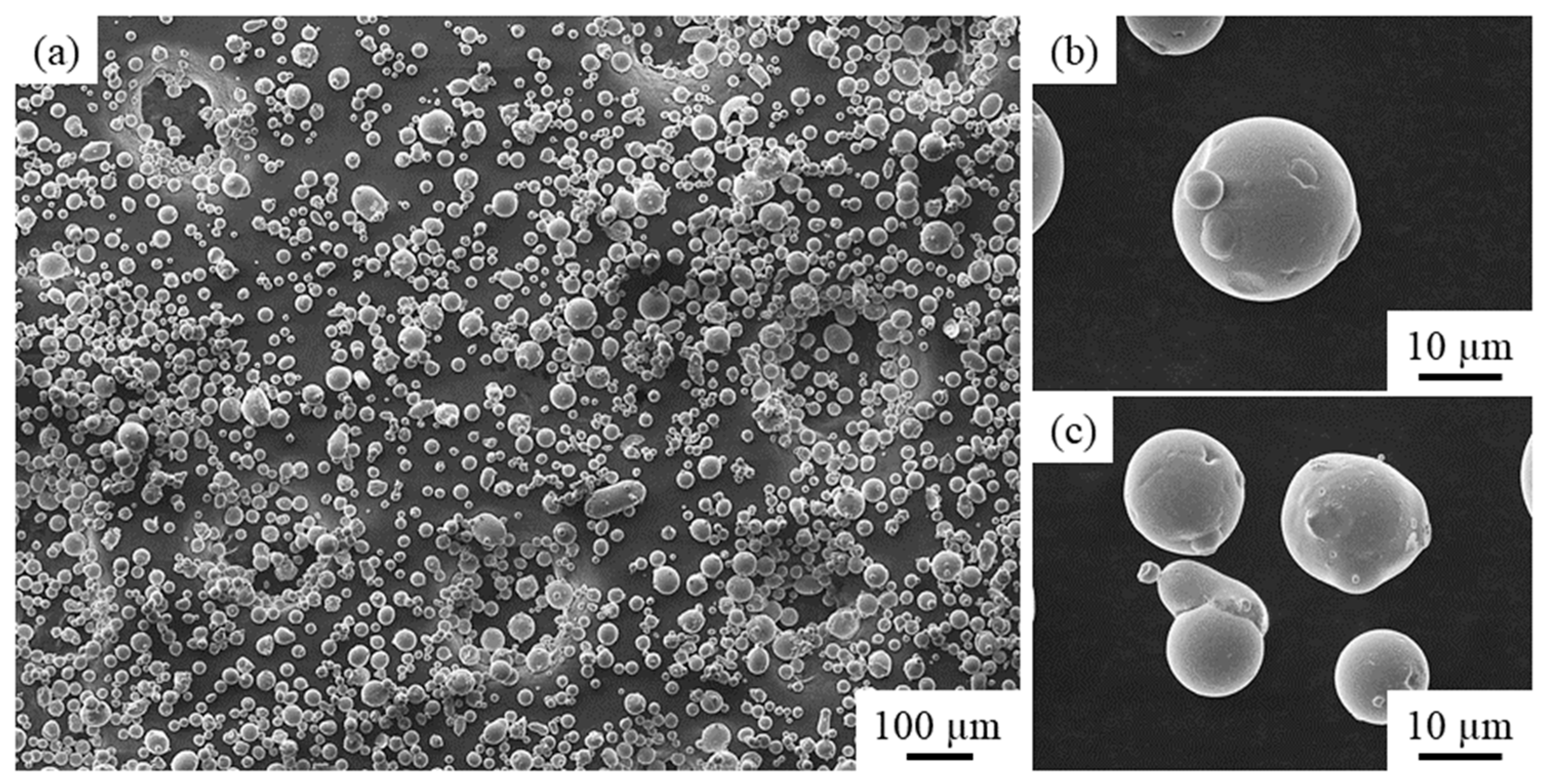
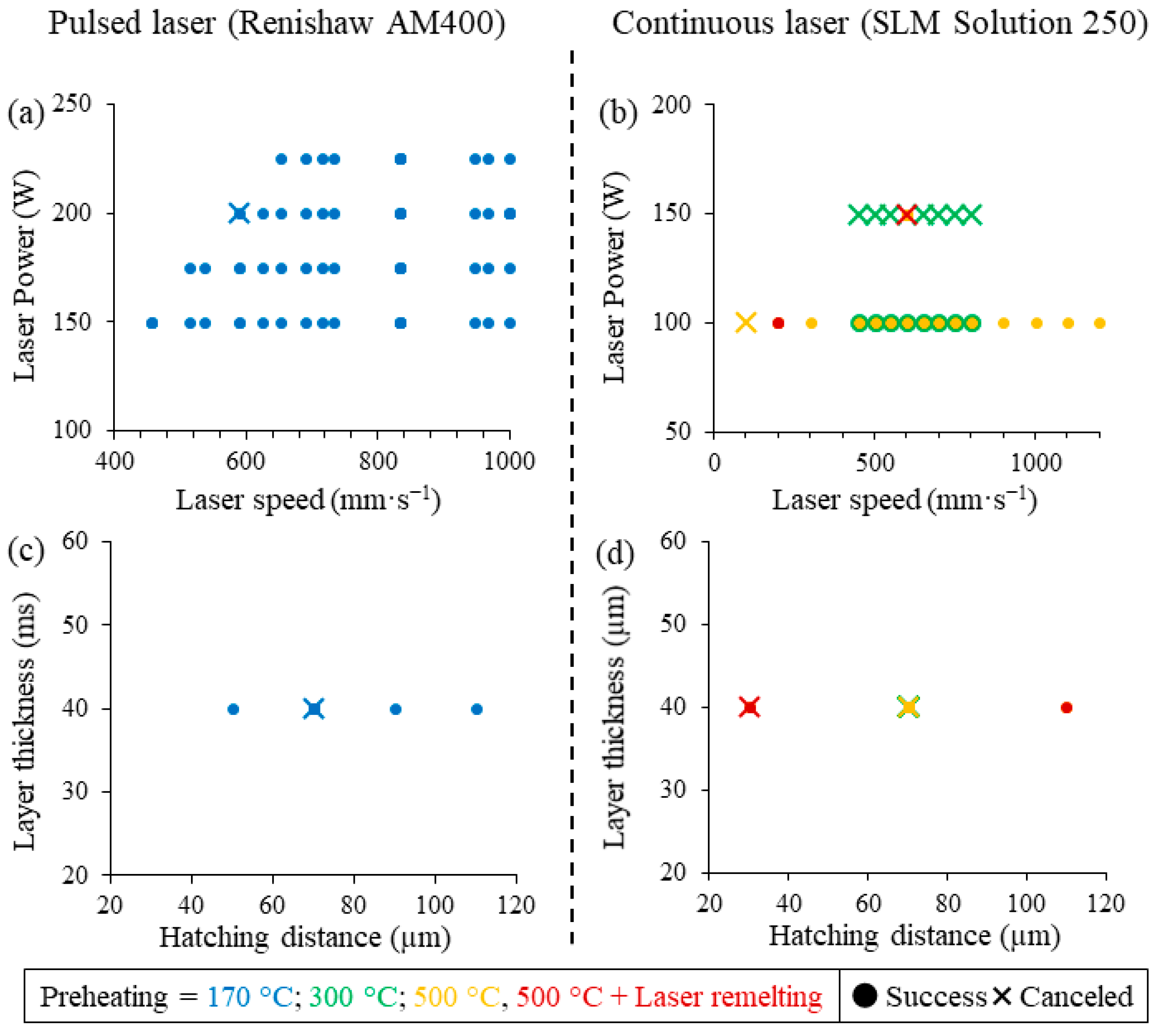
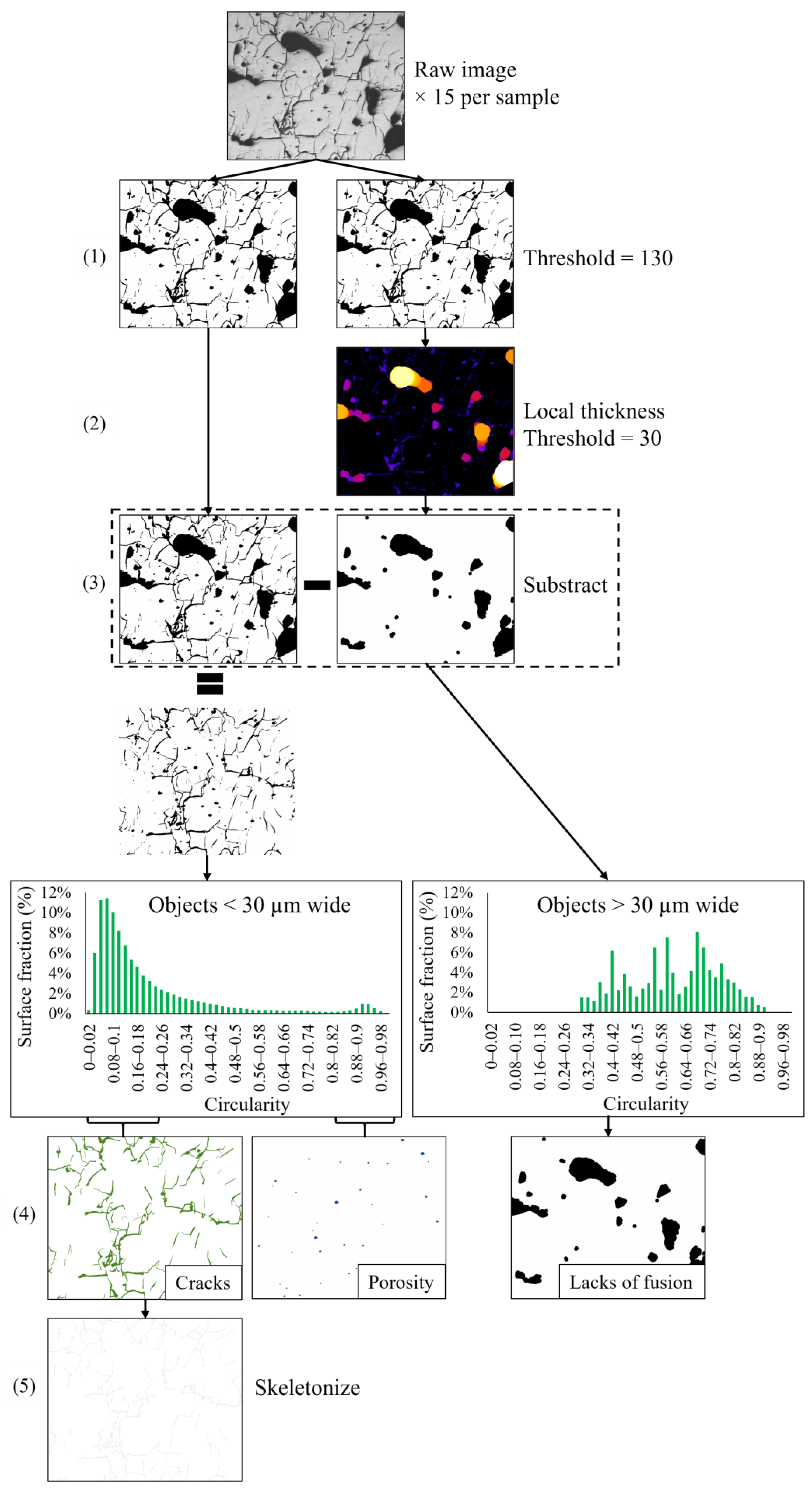
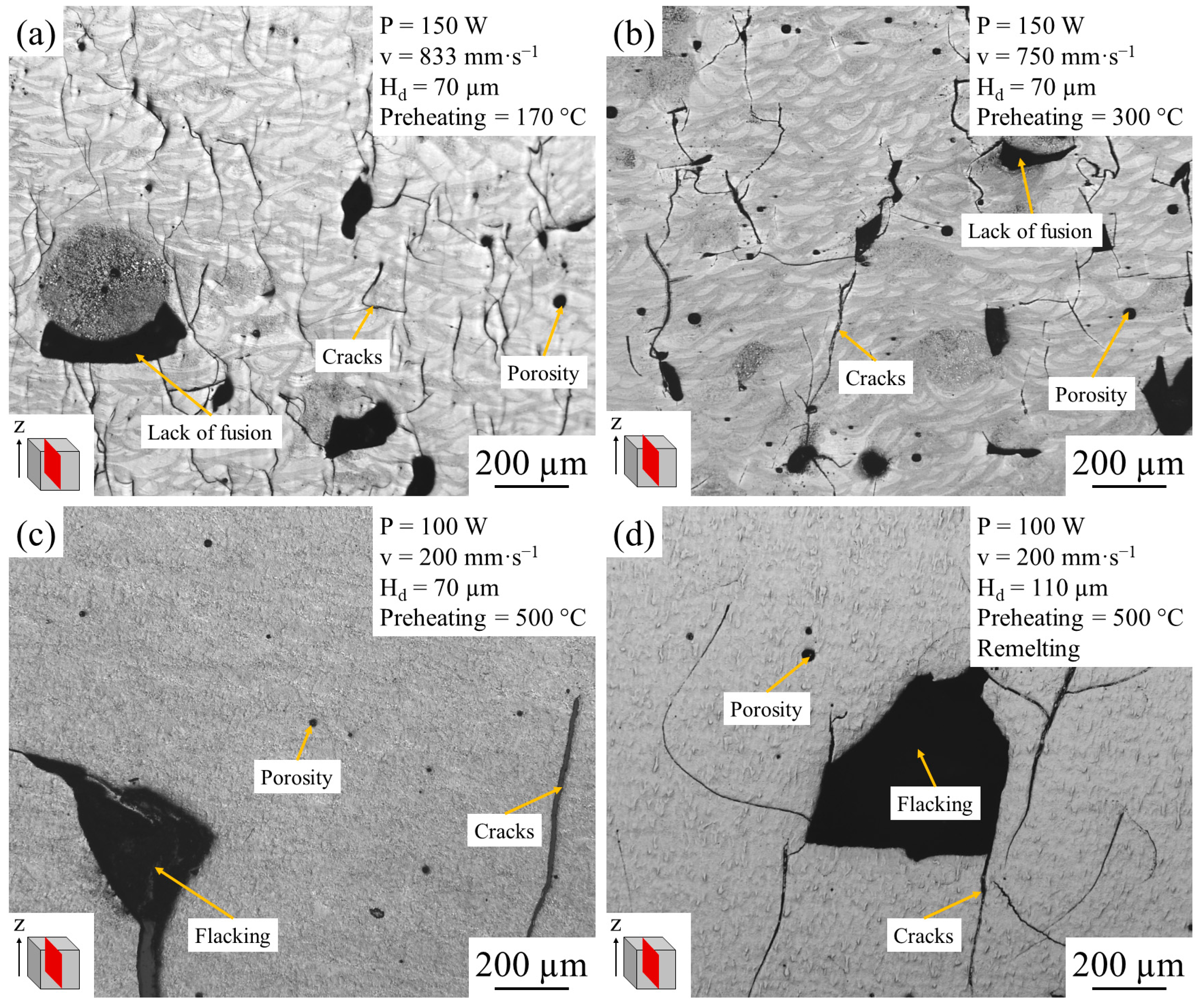
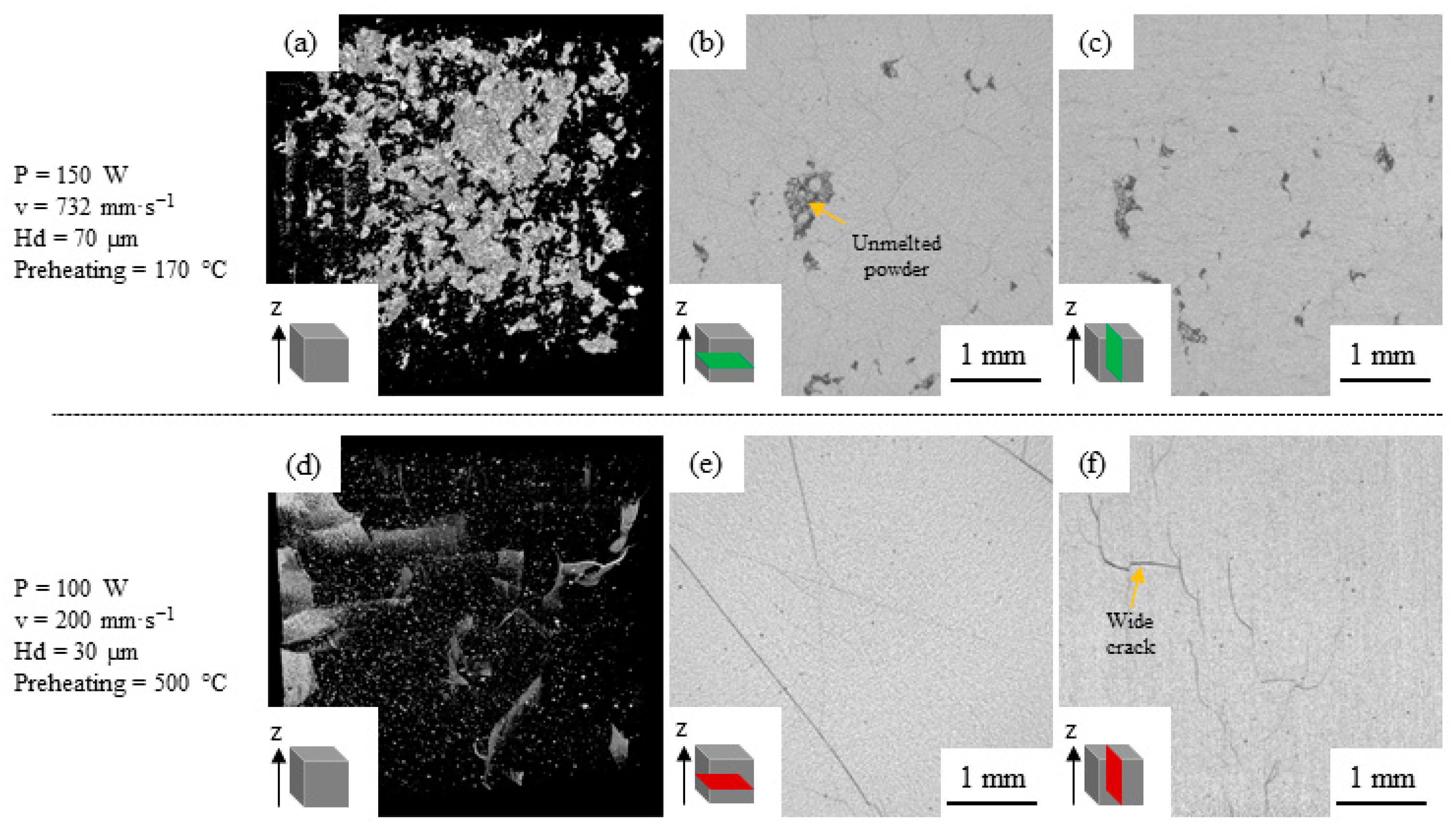
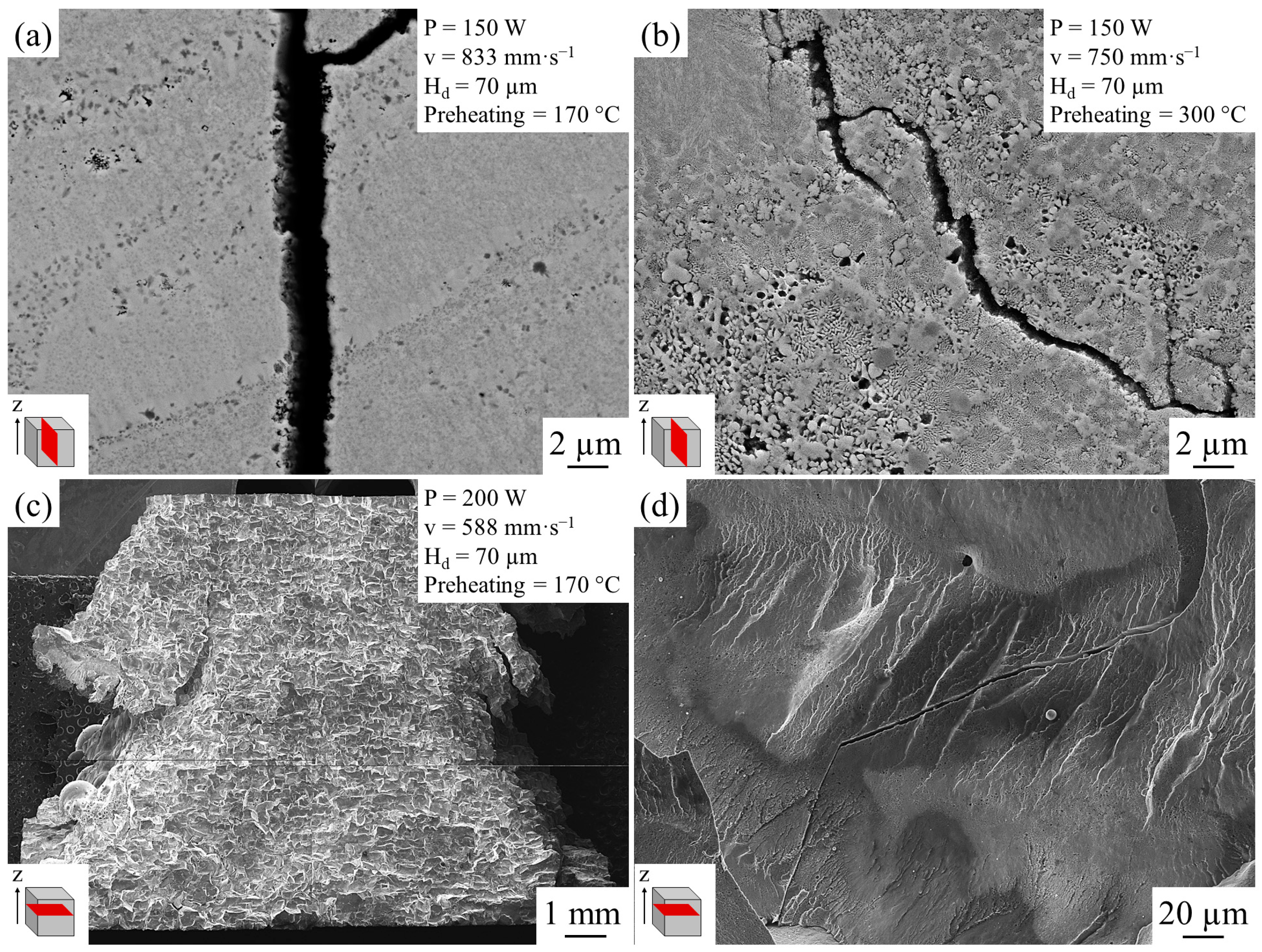
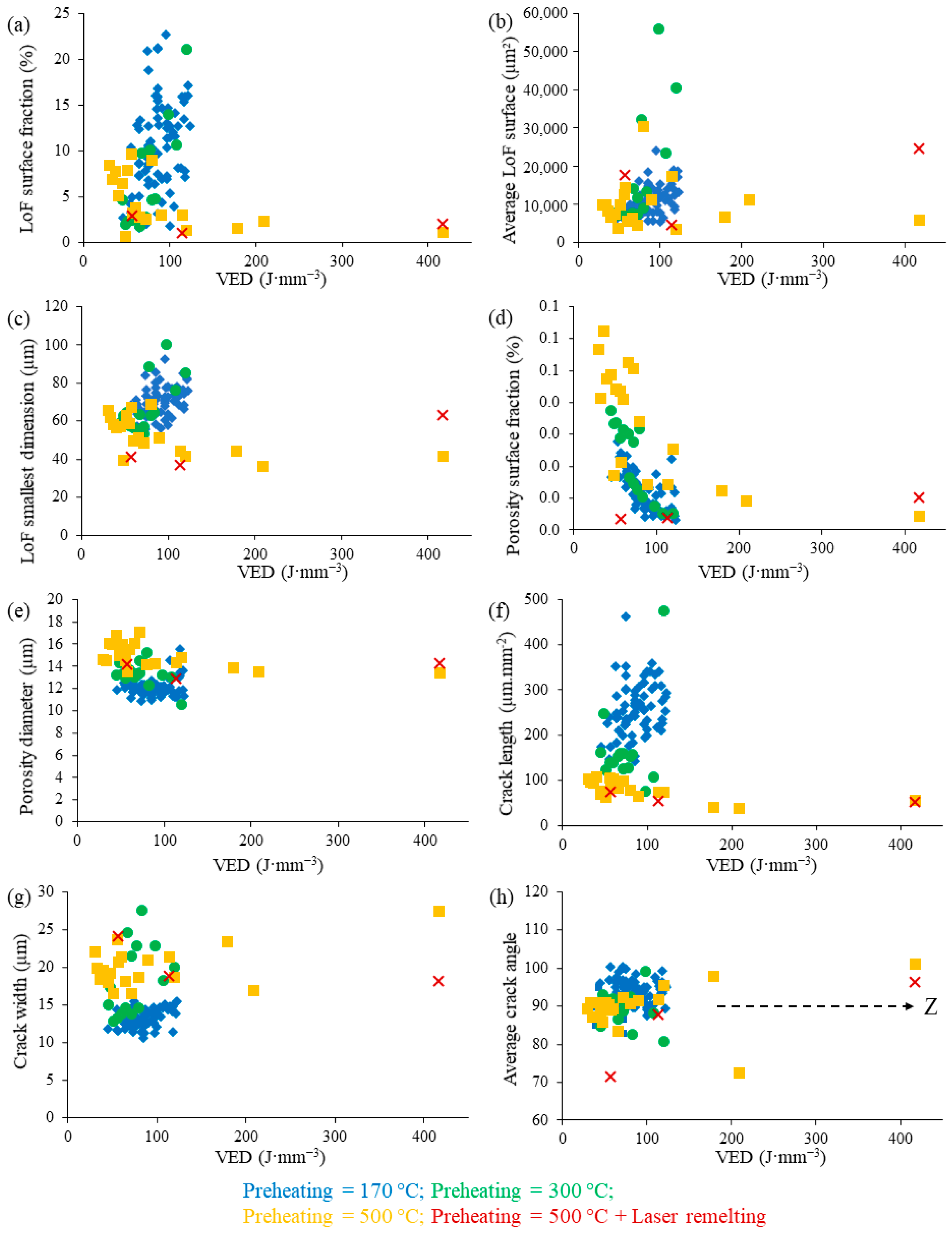
| Elements | Ni | Cr | B | Si | Fe | C | O |
|---|---|---|---|---|---|---|---|
| D60 Bal. | Bal. | 14 | 3.5 | 3.9 | 3.1 | 0.63 | 0.012 |
| P (W) | v (mm·s−1) | Hs (µm) | Preheat (°C) | Surface Density (%) | Crack Width (µm) | Crack Length (mm·mm−2) |
|---|---|---|---|---|---|---|
| 150 | 833 | 70 | 170 | 98 ± 1 | 12 ± 2 | 3.7 ± 0.7 |
| 150 | 732 | 70 | 170 | 98 ± 1 | 11 ± 1 | 4.0 ± 0.4 |
| 200 | 1000 | 50 | 170 | 98 ± 1 | 12 ± 1 | 3.1 ± 0.4 |
| 100 | 550 | 70 | 300 | 98 ± 2 | 15 ± 3 | 2.3 ± 0.4 |
| 100 | 200 | 70 | 500 | 98 ± 2 | 24 ± 11 | 0.6 ± 0.3 |
| 100 | 300 | 70 | 500 | 99 ± 1 | 19 ± 5 | 1.1 ± 0.3 |
| 100 | 750 | 70 | 500 | 99 ± 1 | 19 ± 6 | 1.1 ± 0.5 |
| 100 | 200 | 30 | 500 | 99 ± 1 | 28 ± 9 | 0.9 ± 0.4 |
| 100 * | 200 | 30 | 500 | 98 ± 2 | 18 ± 6 | 0.8 ± 0.3 |
| 100 * | 200 | 110 | 500 | 99 ± 1 | 19 ± 9 | 0.8 ± 0.6 |
Disclaimer/Publisher’s Note: The statements, opinions and data contained in all publications are solely those of the individual author(s) and contributor(s) and not of MDPI and/or the editor(s). MDPI and/or the editor(s) disclaim responsibility for any injury to people or property resulting from any ideas, methods, instructions or products referred to in the content. |
© 2023 by the authors. Licensee MDPI, Basel, Switzerland. This article is an open access article distributed under the terms and conditions of the Creative Commons Attribution (CC BY) license (https://creativecommons.org/licenses/by/4.0/).
Share and Cite
Ty, A.; Balcaen, Y.; Mokhtari, M.; Rigaud, J.; Dalverny, O.; Alexis, J. Material Health of NiCrBSi Alloy Parts Produced via the Laser Powder Bed Fusion Process. Metals 2023, 13, 1669. https://doi.org/10.3390/met13101669
Ty A, Balcaen Y, Mokhtari M, Rigaud J, Dalverny O, Alexis J. Material Health of NiCrBSi Alloy Parts Produced via the Laser Powder Bed Fusion Process. Metals. 2023; 13(10):1669. https://doi.org/10.3390/met13101669
Chicago/Turabian StyleTy, Anthony, Yannick Balcaen, Morgane Mokhtari, Jordan Rigaud, Olivier Dalverny, and Joël Alexis. 2023. "Material Health of NiCrBSi Alloy Parts Produced via the Laser Powder Bed Fusion Process" Metals 13, no. 10: 1669. https://doi.org/10.3390/met13101669
APA StyleTy, A., Balcaen, Y., Mokhtari, M., Rigaud, J., Dalverny, O., & Alexis, J. (2023). Material Health of NiCrBSi Alloy Parts Produced via the Laser Powder Bed Fusion Process. Metals, 13(10), 1669. https://doi.org/10.3390/met13101669







